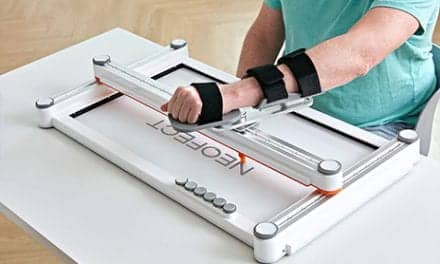May 4, 2007
DynaVox Technologies (www.dynavoxtech.com) has announced the release of the Visual Scene Display communication framework for adults affected by aphasia and traumatic brain injury (TBI) using the company’s popular V and Vmax speech-output solutions.
The new communication framework presents contextually rich visual images to represent meaning and support page navigation. Commonly occurring as the result of stroke, traumatic brain injury and transient ischemic attack, aphasia is the loss of previously learned communication skills resulting from damage to the language centers and their connections in the brain.
Part of a powerful communication strategy that depicts people, activities and objects in relation to one another, the Visual Scene Displays represent familiar situations, places or experiences in which all elements work to present a framework for conversation. This solution reduces the need to navigate between pages to retrieve vocabulary, thereby improving the communication experience. New, contextually meaningful, custom photographs can easily be added to the framework to provide the individual with even greater meaning and familiarity.
The new technology was developed under the leadership of Dr. David Beukelman, PhD, of the University of Nebraska – Lincoln, the University of Nebraska Medical Center, and Madonna Rehabilitation Hospital in Lincoln, and in collaboration with the Augmentative and Alternative Communication-Rehabilitation Engineering Research Center (AAC-RERC),
“In the past, AAC devices were often used by individuals with aphasia or TBI for specific communication activities such as answering the telephone and basic communication functions such as greetings, prayers, jokes, etc.,” Beukelman said. “The Visual Scene Display framework provides a more robust communication experience and a more complete level of interaction support by allowing these individuals to navigate through the display and communicate messages using personal, contextual images rather than line drawings or icons.”
Beukelman continued: “The digital photographs included in a Visual Scene Display provide a shared communication environment for individuals using AAC technology and their listeners. Using personally relevant pictures with associated text, they can co-construct messages and share socially relevant information.”
“For the first time, individuals using advanced speech-output solutions challenged by communication disabilities resulting from aphasia and traumatic brain injury can take advantage of a powerful communication strategy grounded in solid clinical research,” said Linnea McAfoose, MA, CCC-SLP, clinical product manager at DynaVox Technologies. “The Visual Scene Display – Adult communication framework gives those working to overcome the effects of these conditions a powerful base for meaningful communication and unprecedented flexibility for adding new content that is truly meaningful to their lives.”
To learn more, visit www.dynavoxtech.com.


